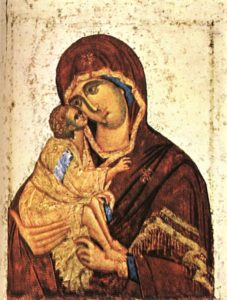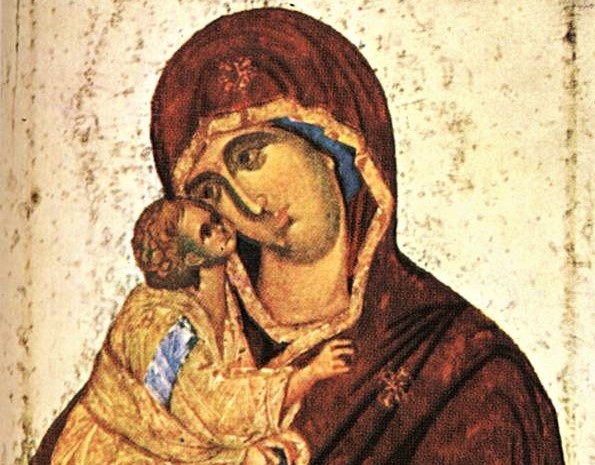
On this Christmas Eve we ponder the approaching mysteries. A question so basic that it does not occur to some to even ask is this: Why did the Lord choose to come to us through a woman, Mary, when He could have come in any manner He pleased?
He could have bypassed conception, gestation, birth, infancy, and youth entirely. He could have appeared suddenly on earth as a grown man — but He did not. Why not?
Remember, too, that although He chose to come through an earthly mother, he bypassed the participation of an earthly father (in the physical sense). If the biological role of a human father was bypassed in His taking flesh, why was the role of a human mother not similarly bypassed?
St. Thomas Aquinas pondered this question in his Summa Theologiae (part III, question 31, article 4) and set forth three reasons. St. Thomas’ commentary is shown below in bold italics, while my poor remarks appear in plain red text.
[Firstly,] Although the Son of God could have taken flesh from whatever matter He willed, it was nevertheless most becoming that He should take flesh from a woman. First because in this way the entire human nature was ennobled. Hence Augustine says (QQ. lxxxiii, qu. 11): “It was suitable that man’s liberation should be made manifest in both sexes.”
So, in this manner both sexes were ennobled. The male sex was ennobled because the Word became flesh and was male. The female sex was ennobled because it was from Mary that Christ took His humanity.
Secondly, because thus the truth of Incarnation is made evident. Wherefore Ambrose says (De Incarnation vi): “Thou shalt find in Christ many things both natural, and supernatural. In accordance with nature he was within the womb … but it was above nature that a virgin should conceive and give birth: that you may believe that He was God, who was renewing nature …”
Both the natural and the supernatural are evident in Christ’s conception and incarnation. St. Thomas emphasized the elevated need for the natural so that we might avoid the heresy of thinking that Christ’s humanity was not real due to its wholly supernatural origin.
And [as] Augustine says (Ep. ad Volus. cxxxvii): “If Almighty God had created a man formed otherwise than in a mother’s womb, and had suddenly produced him to sight … would He not have strengthened an erroneous opinion, and made it impossible for us to believe that He had become a true man? … But now, He, the mediator between God and man, has so shown Himself, that, uniting both natures in the unity of one Person, He has given a dignity to ordinary by extraordinary things, and tempered the extraordinary by the ordinary.”
So, it was fitting that Christ should be born of a woman, Mary, so as not to lose the natural in the supernatural, to show that both the natural (because He is true man) and the supernatural (because He is true God) should balance and complete each other.
Thirdly, … the first man was made from the “slime of the earth,” without the concurrence of man or woman: Eve was made of man but not of woman: [though since], other men are made from both man and woman. So [it] …. remained as it were proper to Christ, that He should be made of a woman without the concurrence of a man.
In other words, it seems fitting or proper that because Adam and Eve were both created outside of the usual order of things, the New Adam, Christ, would be made in a unique manner. Eve was made without the help of another woman, but rather was drawn by God directly from the man, Adam. In a kind of balancing parallelism, God made the New Adam directly from the woman, Mary, without the help of a man.
St. Thomas seems to point to a kind of poetic balance, not a necessary one.
So, here are some interesting insights as to why Christ chose to be born of a woman. Note well however, that these are arguments pointing to fittingness, not necessity. Saying that something is fitting does not mean that it is required, only that it is well suited to the situation. On the one hand, something can be fitting because, by it, we humans can more easily understand it. On the other, something can be fitting because it best suits God’s own purposes.


Thank you so much–you are always very much worth reading–so helpful!
That is one of the things that always bothered me about Aslan in The Chronicles of Narnia: he had no mother and was not really related to any of the other talking animals, not even the lions.
The poetic “fittingness” of Christ being born of the Blessed Mother without aid of St. Joseph is easy to grasp. I think Christ’s birth makes it possible for us to accept with certainty both his humanity and divinity in one person, though there are those who do doubt it still, despite the fact that the Fathers and Doctors of the Church have all wrestled with these same questions before our time.
As regarding “Aslan,” he is Jesus himself but in a different universe with a different historical origin, perhaps with a different economy of salvation. After all, sin did not enter “Narnia” in the same way it entered our universe. Jesus’ method of operating seems to work well within that story of C.S. Lewis’s sub-creation.
The first “transubstantiation” in history happened in Mary’s body. Why is it that transubstantiation cannot happen via ordained women?
The incarnation was not a « transubstantiation », but a « hypostatic union. » Jesus was not human in accidents, but God in essence. « The Athanasian Creed explains the « hypostatic union » : He is God from the essence of the Father, begotten before time; and he is human from the essence of his mother, born in time; completely God, completely human, with a rational soul and human flesh… »
Luis,
Merry Christmas,
A non-theological answer: although it was in a woman’s womb that God took on flesh, it was not the woman’s doing, she was not the cause, it was God’s.
Similarly, although it is in the church that the consecration occurs, it is not the Church i.e. the woman or Bride of Christ who does it or its the cause, but God, through the priest, who at that point acts in Persona Christi i.e. the male element, who is the cause.
If the priest were a woman, it would present, at least symbolically, the misleading (heretical) idea that Mary was the power or cause behind the Incarnation.
I presume, of course, that you don’t think Mary was the cause for God becoming man.
Satan used the disobedience of Eve as part of his attack on Adam. It is fitting that to completely defeat Satan, God should use the obedience of Mary in the rescue of Adam and Eve and their children.